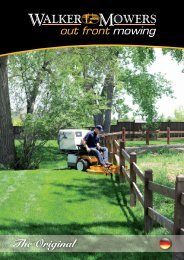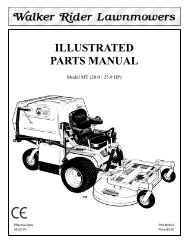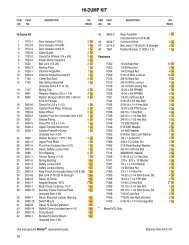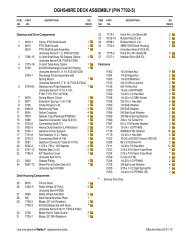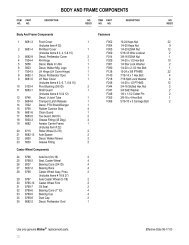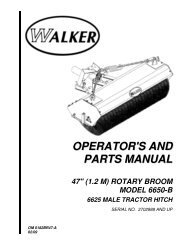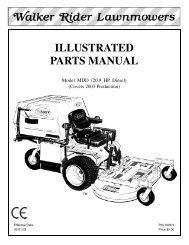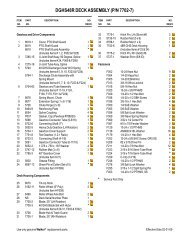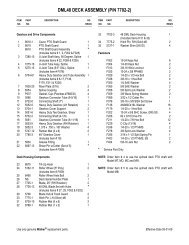1998 S/N 21329 - Walker Mowers
1998 S/N 21329 - Walker Mowers
1998 S/N 21329 - Walker Mowers
Create successful ePaper yourself
Turn your PDF publications into a flip-book with our unique Google optimized e-Paper software.
Operating Instructions<br />
Steering Levers<br />
Choke<br />
Engine Throttle<br />
Choke and Throttle Location<br />
The throttle control lever (red knob) is located on the<br />
left side of the seat and is used to control engine<br />
speed. Moving the lever forward toward the FAST<br />
position increases engine speed; moving it backward<br />
toward the IDLE position decreases engine<br />
speed.<br />
Forward Speed Control (FSC)<br />
Throttle<br />
Forward Speed Control (FSC) has two functions:<br />
One is to set forward travel speed, and the other is<br />
to establish the NEUTRAL-PARK position. When<br />
the FSC lever is moved into the FORWARD position,<br />
a friction lock holds any forward speed setting<br />
from 0 to 5 mph (0 to 8 km/h). The ground speed is<br />
proportional to the lever position; the further the lever<br />
is advanced forward, the faster the tractor<br />
moves. It is not necessary to hold the FSC in position<br />
since the friction lock maintains the selected lever<br />
position. Pulling back on the steering levers<br />
overrides the FSC setting and slows or stops forward<br />
travel. Releasing the steering levers allows<br />
the tractor to resume forward travel at the speed set<br />
by the FSC lever. To stop and park the machine, the<br />
FSC lever is moved backward to the NEUTRAL-<br />
PARK position.<br />
Each drive wheel is controlled by its own independent<br />
steering lever, for both steering function and<br />
FORWARD/REVERSE motion. The FSC lever sets<br />
the maximum forward speed, and also sets the forward<br />
position of the steering levers. The steering levers<br />
operate only with a backward pulling<br />
movement of the lever, which causes the drive<br />
wheel for that lever to first slow down, stop, and then<br />
reverse with a full backward lever stroke. The levers<br />
are released to the FORWARD position for “straightahead”<br />
ground travel.<br />
NOTE: Pushing forward on the steering levers will<br />
not cause any change in tractor motion - there will<br />
be no steering lever reaction and there will be no<br />
machine damage.<br />
Blade Clutch (PTO)<br />
The blade clutch lever has two positions. Pulling the<br />
lever UP engages the PTO that drives the mower<br />
blades. Pushing the lever DOWN disengages the<br />
PTO and engages the blade brake.<br />
NOTE: On GHS equipped models, the Powerfil ®<br />
motor and Grass-Pak ® full signal switch are activated<br />
by engaging the blade clutch. Refer to Using the<br />
GHS Catcher in this section for a complete description<br />
of GHS operation.<br />
Parking Brake<br />
The parking brake functions by locking a pin into the<br />
hydrostatic transmission pinion gear teeth. Moving<br />
the lever FORWARD engages the parking brake;<br />
moving the lever BACKWARD releases the brake.<br />
IMPORTANT: Stop the tractor completely before<br />
engaging the parking brake. The parking brake uses<br />
a positive mechanical lock similar to the PARK position<br />
on an automotive automatic transmission. If<br />
the tractor is moving when the brake is engaged, it<br />
will result in sudden stoppage and possible internal<br />
damage to the axle drive.<br />
NOTE: If pressure on the parking brake pin (e.g.<br />
parked on a hill) makes it impossible to release the<br />
parking brake with the parking brake lever, move the<br />
mower gently forward or backward to release the<br />
pin.<br />
25



